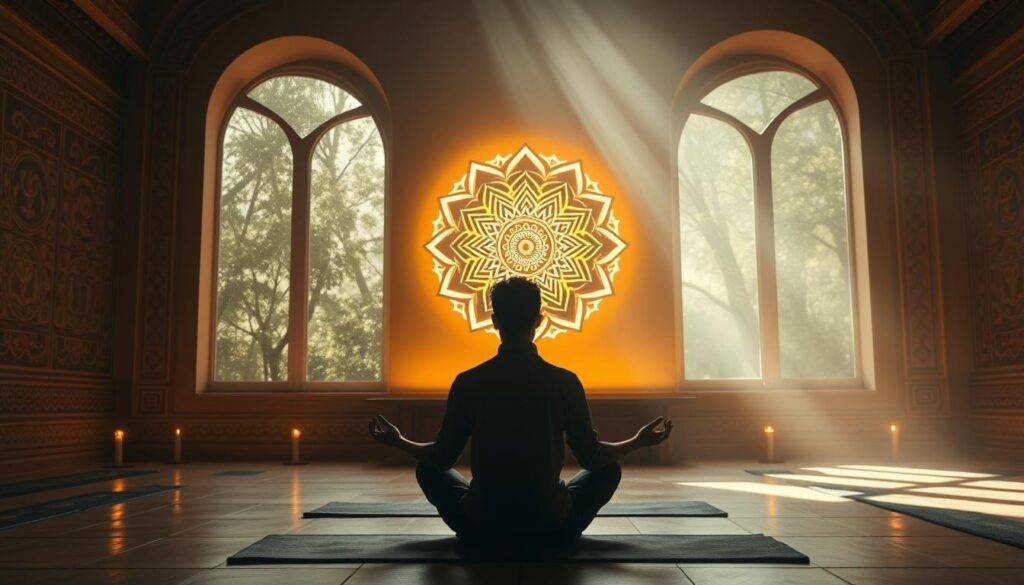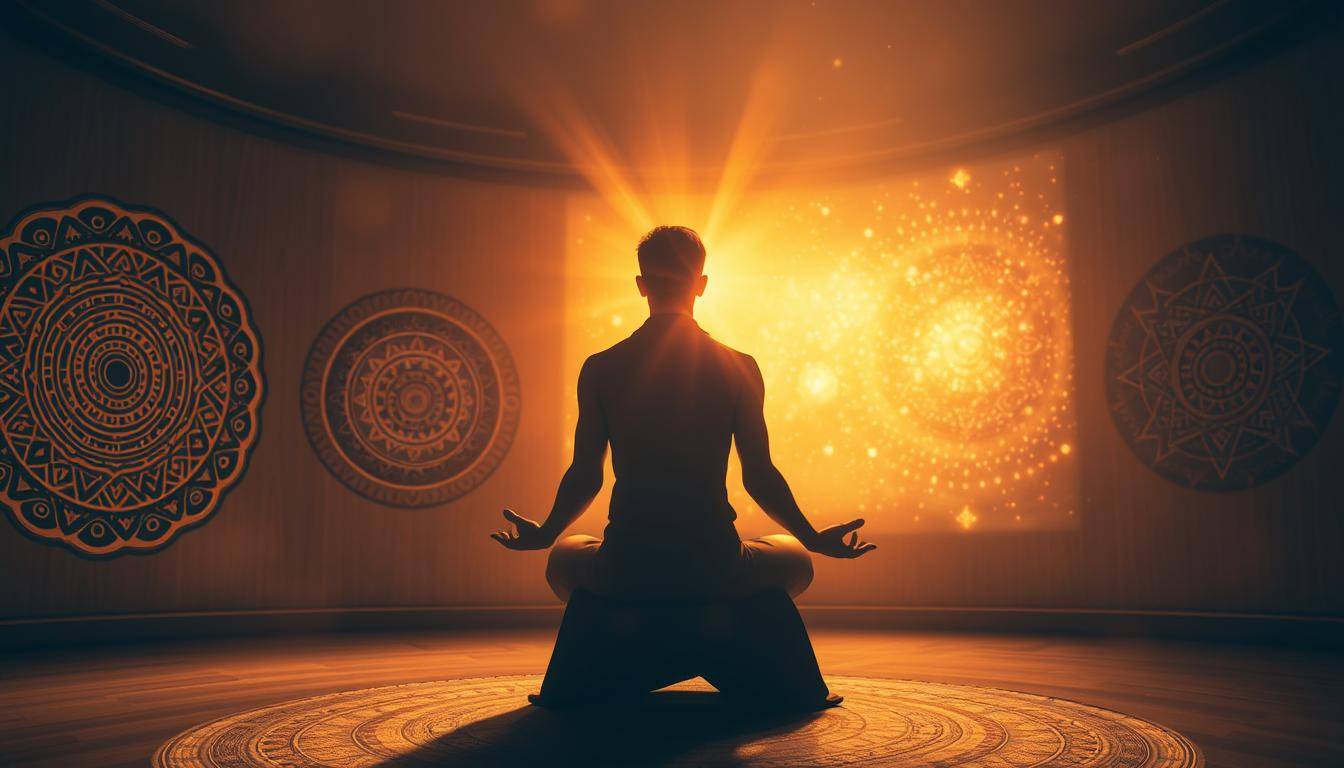“The mind is everything. What you think, you become,” said Buddha. This timeless wisdom echoes the transformative power of practices that unlock deeper layers of awareness—a journey this guide will help you navigate.
Unlike standard relaxation techniques, superconscious meditation transcends ordinary mental states. It’s a systematic process—pioneered by teachers like Swami Rama—that retrains awareness to access profound clarity. Think of it as upgrading your mind’s operating system.
This practice isn’t about emptying thoughts. Instead, it actively channels inner wisdom through disciplined focus. Over time, practitioners learn to shift from chaotic thinking to a calm, observant state—a skill requiring guidance and consistency.
Why does structure matter? Research shows methods with clear steps yield faster progress. You’ll discover how specific techniques create neural pathways for sustained peace and decision-making clarity. The rewards compound, much like physical training for the mind.
Key Takeaways
- Transcends basic relaxation to unlock elevated awareness
- Requires consistent practice for lasting neural changes
- Rooted in time-tested methods from Eastern traditions
- Focuses on redirecting attention rather than suppressing thoughts
- Delivers practical benefits like mental clarity and emotional balance
Foundations and Preparation for Meditation
Imagine trying to run before learning to walk—mastering basics first makes advanced practices achievable. The Raja Yoga tradition emphasizes this principle, teaching that systematic preparation of the body and mind creates the ideal conditions for growth. Like tuning an instrument before a concert, these steps ensure your practice resonates with clarity.
Understanding the Raja Yoga Approach
This ancient method treats meditation as a science. It begins with diaphragmatic breathing—inhaling deeply through the nose while expanding the abdomen. Studies show this technique activates the parasympathetic nervous system, shifting your state from stress to calm. Proper spinal alignment matters too; sitting tall allows energy to flow freely without strain.

Laying the Groundwork: Posture, Breathing, and Relaxation
Start with a comfortable seated position—cross-legged or in a chair. Place hands on knees, palms up. Focus on uniform breaths: four counts in, four counts out. This rhythm calibrates mind and body, creating a feedback loop of awareness.
Next comes shithili-karana—progressive muscle relaxation. Tense and release each body part from toes to scalp. One study found this technique reduces neuromuscular tension by 37% faster than standard methods. Pair it with the mantra “Soham” (meaning “I am”) to anchor attention.
Consistency transforms these steps into habits. As Swami Rama noted, “The mind becomes what it practices daily.” Resources like Science of Breath offer deeper insights into these foundational tools for modern life.
Mastering Superconscious Meditation Techniques
Just as a musician masters scales before performing symphonies, refining mental focus demands precise methods. These practices build on foundational skills to navigate deeper states of clarity—a journey where vibrational tools and mental discipline merge.

Harnessing Mantras for Deeper Awareness
Mantras act as sonic anchors, using vibrational resonance to quiet mental chatter. Traditional practices like those taught by Swami Rama use sounds like “So’ham” (I am) not for their meaning, but their rhythmic pulse. This repetition creates a feedback loop—the mind shifts from analyzing words to syncing with their energy.
Transitioning from Surface to Subconscious States
Begin by consciously repeating your chosen phrase. As focus deepens, allow the sound to operate at a subconscious level. Research shows this shift typically occurs within 8-10 minutes of steady practice. The key? Let go of effort. Like floating in water, mental effortlessness invites deeper immersion.
Retraining Awareness for Sustained Clarity
Consistency rewires neural pathways. A study in Frontiers in Psychology found daily 20-minute sessions improved attention spans by 14% in six weeks. Pair mantras with a receptive attitude—view distractions as cues to gently refocus. Over time, this process cultivates an observant mindset that operates beyond surface-level reactions.
As Swami Rama noted, “The mind mirrors its training.” Whether using introductory techniques or advanced mantra-diksha, the path to elevated awareness thrives on disciplined repetition and patient self-trust.
Integrating Meditation Practice into Daily Life
True growth happens when practice leaves the cushion and enters the commute. This process retraining awareness transforms routine moments into opportunities for clarity—a skill as vital as mastering formal sessions.

Utilizing Techniques in Stressful Moments
Next time tension arises—a delayed flight or heated meeting—pause. Breathe deeply through the nose for four counts. Studies show this conscious-subconscious shift lowers cortisol 23% faster than passive relaxation. It’s not about eliminating stress, but changing how you think way through it.
Practical Strategies for Lasting Balance
Try micro-sessions: two minutes hourly to reset focus. Pair them with existing habits—after coffee breaks or before checking emails. Research confirms these brief pauses improve decision accuracy by 18%.
Create environmental cues. A phone wallpaper with the mantra “Soham” reminds you to operate consciously during chaos. Track progress weekly—notice when reactions become responses. As one neuroscience paper notes: “Neural rewiring thrives on repetition, not duration.”
This practice goal isn’t perfection, but progressive mastery. Whether recalibrating during traffic jams or refining focus before presentations, each moment becomes a stepping stone. The mind learns to access calm on demand—true guidance for modern challenges.
Conclusion
True transformation begins when practice becomes a mirror—reflecting inner wisdom through disciplined focus. This journey from foundational breathing to advanced mantra techniques isn’t about escaping thoughts but mastering how your awareness operates. By retraining awareness, you uncover clarity that reshapes reactions into conscious responses.
The path to superconsciousness thrives on consistency, not perfection. Research shows even brief daily sessions at the subconscious level strengthen neural pathways—accessing superconsciousness becomes natural over time. Mental noise fades, revealing an intuitive guide within.
Integrating these principles turns daily challenges into growth opportunities. Techniques like those in subconscious reprogramming help maintain balance when stress arises. The key point? Progress isn’t linear, but each step builds resilience.
Your mind’s potential grows when you listen deeply—not to external sounds but to silent understanding. Start small, stay receptive, and trust the process. The goal isn’t to reach a finish line but to embrace the endless possibilities of an awakened perspective.
FAQ
How does this method differ from standard relaxation practices?
Unlike basic relaxation techniques, this approach systematically retrains how awareness operates across conscious and subconscious levels. It combines posture refinement, mantra work, and intentional focus shifts to cultivate lasting mental clarity rather than temporary calm.
Why is physical alignment emphasized in early stages?
Proper posture creates an optimal energy flow pattern, allowing deeper states of focus without physical distractions. It establishes a stable foundation for transitioning between ordinary awareness and elevated states of perception.
Can mantras enhance results even for skeptics?
Research-backed vibrational patterns in specific sound formulas help bypass analytical thinking. When used consistently, they act as cognitive anchors—quieting surface thoughts to access deeper wisdom layers, regardless of initial beliefs.
How quickly can practitioners expect tangible changes?
Most notice improved stress resilience within 2-3 weeks of daily sessions. Lasting transformation in decision-making and creativity typically emerges after 8-12 weeks as neural pathways adapt to sustained awareness retraining.
What’s the minimum effective daily practice time?
Beginners benefit most from 15-minute morning sessions paired with brief “micro-practices” during the day. Consistency matters more than duration—regular short sessions build stronger neural rewiring than sporadic long ones.
How does this help during high-pressure situations?
The techniques develop a reflexive pause between stimulus and response. Practitioners learn to access calm clarity mid-crisis by recalling trained breathing patterns and mental focus points from their sessions.
Can these methods conflict with religious beliefs?
The system operates on universal principles of consciousness mechanics, not doctrine. Many users integrate it with their existing spiritual frameworks, using the tools to deepen rather than replace personal belief systems.




























































